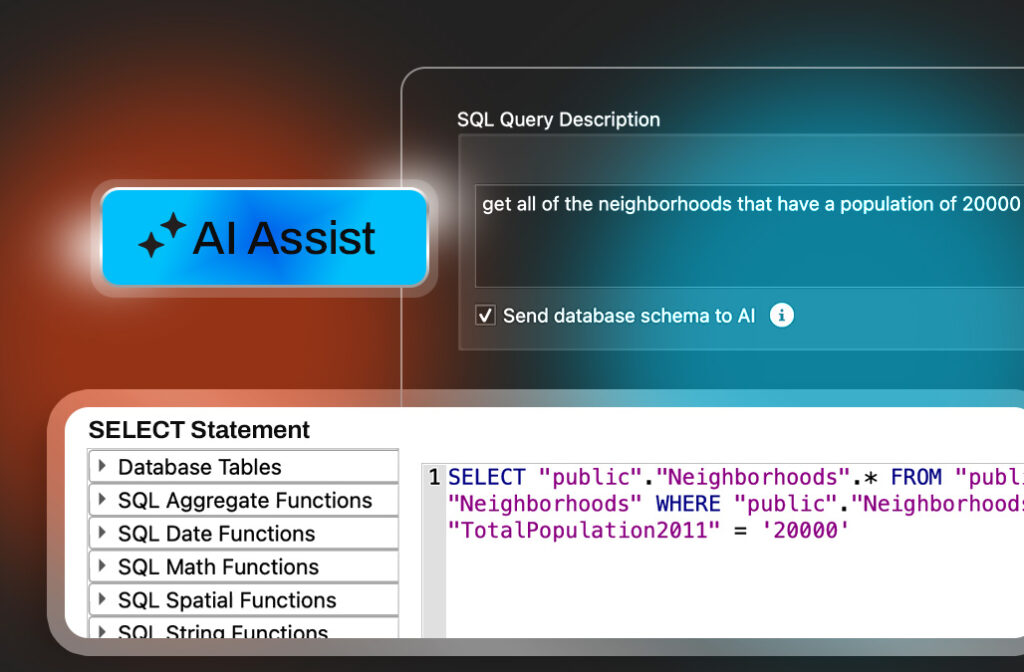Key takeaways:
- The ArcGIS Data Interop extension is powered by FME Form, letting you build ETL workflows to convert and transform data directly within the ArcGIS environment.
- The full FME Platform (including FME Flow) also includes advanced functionality like Automations, Data Virtualization, no-code web apps, real-time data streaming, and more.
- An FME Subscription is a powerful companion to Data Interop that enables Esri software to integrate and expand beyond the GIS space and throughout the enterprise.
The ArcGIS Data Interoperability extension embeds FME Form capabilities directly inside ArcGIS Pro, enabling powerful ETL (extract, transform, load) workflows with support for a wide range of formats.
Because Data Interop is built on FME technology, users benefit from a piece of the FME engine right inside the ArcGIS environment. But the full FME Platform is much larger, including enterprise automation functionality offered by FME Flow. For users who want to integrate and expand throughout the enterprise and beyond the GIS space, the FME Platform is a powerful companion that helps you scale and automate your workflows.
Let’s look at what Data Interop makes possible, and how to get the most out of your data with the full FME Platform.
What does Data Interoperability include?
Data Interop is powered by FME technology. It is essentially a subset of FME Form, and it was designed so ArcGIS users could take advantage of Safe Software’s industry-leading format support and intuitive, no-code approach to data integration.
With Data Interop, you can:
- Convert data between formats, with access to a wide variety of formats natively supported by FME.
- Transform, clean, restructure, and prepare data inside ArcGIS via Spatial ETL tools, the Quick Translator, or Workbench.
- Leverage FME’s repeatable, no-code ETL processes while staying in your familiar ArcGIS environment. The functionality is integrated directly into ArcGIS Pro, ModelBuilder, and ArcGIS Enterprise workflows.
- Publish to ArcGIS Enterprise. Share geoprocessing services that draw on Data Interop functionality.
If you’re using Data Interop, you’re already tapping into part of FME’s powerful ecosystem, purpose-built for GIS professionals. However, you are not getting the larger and arguably more exciting enterprise capabilities, which we’ll discuss below.
What does Data Interop not include?
Data Interop doesn’t include the powerful enterprise features in FME Flow:
- Automations: Orchestrate multi-step, event-driven data workflows with no coding.
- Data Virtualization: Build APIs on top of any data source, enabling live access to your data.
- No-Code Web Apps: Easily create web apps to enable end users to interact with FME workflows.
- Real-Time and IoT Processing: Process and publish high-velocity, real-time data streams from various sources.
- Augmented Reality (AR): Bring any data into the context of the real world with custom AR workflows and the free FME Realize app.
How can an FME Subscription work alongside Data Interop?
Data Interop is fantastic for ArcGIS-centric workflows. An FME Subscription expands upon this functionality, offering more scalability and automation. The entire FME Platform, including FME Flow for automations, is the key technology to help Esri software integrate and expand throughout the enterprise and beyond its traditional space in GIS.
Here’s how FME builds on your Data Interop experience:
1. Data integration beyond the GIS environment
FME supports hundreds of formats and applications beyond GIS, including cloud apps, enterprise IT systems, and more. If you need to integrate more enterprise systems, FME is the natural extension.
2. Enterprise automation & orchestration
With FME Flow, you can automate workflows at scale. For example:
- Run jobs on a schedule or in response to events.
- Scale processing across servers and the cloud.
- Provide data services to your organization through APIs.
FME facilitates cross-team collaboration, and your organization’s workflows can extend into enterprise-wide integration pipelines.
3. Advanced capabilities
FME includes access to the latest innovations and tools, such as:
-
- AI Assist (Build and enhance workflows faster with AI-powered suggestions.)
- Data Virtualization
- Automations
- FME Realize (AR)
- Data Streams
- No-Code Web Apps
4. Work in the latest FME version
Data Interop runs on the previous release of FME. With an FME Subscription, you gain access to the latest versions of FME as soon as they’re released, so you always have the newest formats, transformers, and functionality. You can even experiment with new features and capabilities in early-access environments.
5. Free Safe Software training and support
Safe Software’s free instructor-led online training is included with your subscription to help your team learn FME quickly. Plus, the FME Community is always there to help and provide support.
Conclusion
Data Interop is a powerful FME toolkit inside ArcGIS that provides everything you need for GIS-focused integration and ETL. And when you’re ready to tap into enterprise automation, an FME Subscription opens up the full workshop.
To learn more about Data Interoperability, check out Esri’s learning path or their blog on how Data Interop relates to FME.
To learn more about how FME could fit alongside your ArcGIS workflows, explore Safe Software’s overview of Data Interop and FME.
And of course, feel free to reach out to us. We’re here to help you figure out whether expanding into the broader FME platform is right for you.




